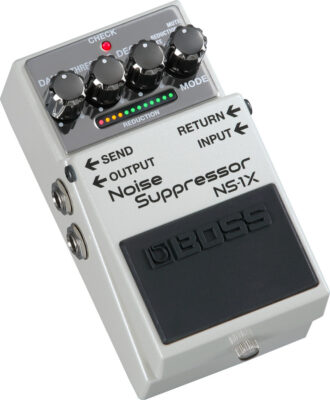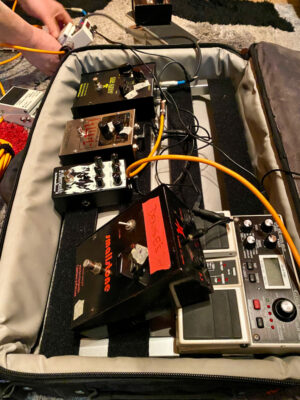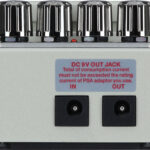Boss NS-1X Noise Suppressor Pedal Review: Taking On Studio Static
How does the Boss NS-1X Noise Suppressor Pedal perform in the recording studio, away from the stage and rehearsal space? Let’s find out.
Boss recently released the NS-1X Noise Suppressor pedal, which promises a “next generation noise suppressor and gate, and other electronic instruments.” The new pedal uses “intelligent” Boss MDP technology, with a variety of modes catered to keeping playing feel authentic and without affected delay in responsiveness of the player’s experience.
Having a pedal that can suppress noise is useful in recording for maintaining sound isolation for other instruments, or even live, for reducing pesky hum bleeding into other mics. Designed to be a versatile tool for live performance and recording, we were curious how the NS-1X would perform in the studio, so we took it for a test run.
A visit to MonoLisa Studios in NYC’s Long Island City offered an opportunity for guitarist/studio owner Denise Barbarita and me to put the NS-1X through its paces.
Features:
The NS-1X eliminates noise and hum for guitar, bass, effects and amplifier setups, making it applicable to multiple studio uses. Let’s take a look at the features that make the NS-1X do its thing.
It uses Boss’ MDP (Multi-Dimensional Processing) technology that preserves the natural feel of guitar and bass playing, and intelligently silences noises, especially useful during set up and recording. The varying modes offered on the pedal cater to varying concerns and playing and recording needs.
For example, while in Gate mode, you have the option of setting the rate which can allow for a speedier gate, all the while maintaining fast attack of high gain riffs. This means that the playing is still super-sensitive to articulations like tapping, sweep picking and more, without the noise. Threshold and Decay knobs allow for shaping the elimination/suppression rate, and control over the amount desired. There’s also a Send/Return loop which helps with noise in overdrives, and other pedals that might otherwise add unwanted noise.
The controls are:
- Mode, a selector switch for toggling between modes (Gate, reduction and Mute)
- Damp
- Threshold
- Decay
- Pedal Switch
(There is also an indicator, serving as a check battery, and a reduction indicator.) .
The NS-1X has an anticipated battery life of 6.5 hours if using an alkaline battery, or can be used with an AC adapter. The pedal can also send power to other pedals in the chain..
In use:
We tested the Boss NS-1X in both distorted and clean applications to see how it would change the sound, if at all.
We initially had some very noisy cables, which the gate hit hard and was able to reduce quite a lot of the cable noise. However, this was affecting the sound a little because the gate was having to work so hard. Since we were in an unaffected setting, (commonly known as clean to guitarists) the gate was noticeable on the decay of the tails of the clean notes. This took a little tweaking with the pedal’s decay settings to get the sound just right, but careful adjustments did the trick.
After a few tests we swapped out the noisy cables to some quieter ones, and repeated the tests to see how the NS-1X’s behavior might change. We noticed that some of the tails of the notes on cleaner settings still required more tweaking so that they weren’t audibly cut off, and that to really preserve the true tone and sound would take a little finessing between the pedal’s settings, and the guitarist (Denise).
To our ears, the gated aspects were actually quite pleasant on a distorted sound, making the crunch seem to pop and open up a bit more, while bringing extra presence to the riffs’ attack. In this way, we saw that this pedal could also be useful in creative applications.
The NS-1X was very useful at reducing amp noise, and its impact was really noticeable just toggling the pedal off and on when Denise wasn’t playing anything. (This makes the on/off switch a good feature to engage, for example, in a recording situation where the amp is hanging around in the background with no iso-booth available.)
To Be Critical:
It took more time than we anticipated to get things adjusted to the point that we felt the NS-1X wasn’t affecting the instrument’s tone. Is it achievable? Absolutely, but it does take some work to dial it in, and like anything the more you use it, the easier it might be to quickly get the desired result. That said, every guitarist feels different about their tone, which means it won’t always be a quick process to hone the exact sound they’re looking for.
The NS-1X is certainly effective at its core mission of noise suppression when there’s unwanted noise from cables, amps, or pedal board configurations. Since this pedal does require some dialing in, however, be prepared when using it in a studio environment where time is of the essence.
Summing Up:
From our tests, we learned that this pedal is quite powerful when applied, and that it does require some time to adjust both the settings amounts and speeds of reduction and gates, but also to the type of playing and the other effects in the chain. In other words, you’ll need a little time in a recording studio situation, for the guitarist and yourself to adjust a few things before hitting record. They may even need a few test runs to make sure it functions well with their playing before committing a proper take. Initially, one might think that it’s a simple plug and play, but in reality it’s much more complex and powerful than that.
Available for an MSRP of $199.99, Boss’ NS-1X Noise Suppressor pedal is a good tool to have around your recording studio, in a pinch, and especially if you’ve got some problem child amps that you’d like to have on more recordings. It’s also useful for some pesky and noisier effects/pedalboard scenarios to rid your recording of unwanted hum, buzz, and potential RF, making for a less sonically cluttered recording. (Your room mics will thank you, if you don’t have an iso booth for the amp!)
The NS-1X takes some finesse to master, and some tone aficionados might not want it in their signal chain. For guitarists, bassists, and audio engineers focused on sharpening up their studio sound, however, this pedal just could be the perfect fix when the noise is getting out of hand.
— Kallie Marie is a contributor to SonicScoop. She is the author of “Conversations with Women in Music Production“, available now from Backbeat Books.
Please note: When you buy products through links on this page, we may earn an affiliate commission.









